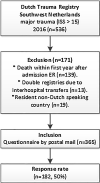Health-related quality of life and return to work 1 year after major trauma from a network perspective
- PMID: 34514511
- PMCID: PMC9192406
- DOI: 10.1007/s00068-021-01781-2
Health-related quality of life and return to work 1 year after major trauma from a network perspective
Abstract
Introduction: Major trauma often results in long-term disabilities. The aim of this study was to assess health-related quality of life, cognition, and return to work 1 year after major trauma from a trauma network perspective.
Methods: All major trauma patients in 2016 (Injury Severity Score > 15, n = 536) were selected from trauma region Southwest Netherlands. Eligible patients (n = 365) were sent questionnaires with the EQ-5D-5L and questions on cognition, level of education, comorbidities, and resumption of paid work 1 year after trauma.
Results: A 50% (n = 182) response rate was obtained. EQ-US and EQ-VAS scored a median (IQR) of 0.81 (0.62-0.89) and 70 (60-80), respectively. Limitations were prevalent in all health dimensions of the EQ-5D-5L; 90 (50%) responders reported problems with mobility, 36 (20%) responders reported problems with self-care, 108 (61%) responders reported problems during daily activities, 129 (73%) responders reported pain or discomfort, 70 (39%) responders reported problems with anxiety or depression, and 102 (61%) of the patients reported problems with cognition. Return to work rate was 68% (37% full, 31% partial). A median (IQR) EQ-US of 0.89 (0.82-1.00) and EQ-VAS of 80 (70-90) were scored for fully working responders; 0.77 (0.66-0.85, p < 0.001) and 70 (62-80, p = 0.001) for partial working respondents; and 0.49 (0.23-0.69, p < 0.001) and 55 (40-72, p < 0.001) for unemployed respondents.
Conclusion: The majority experience problems in all health domains of the EQ-5D-5L and cognition. Return to work status was associated with all health domains of the EQ-5D-5L and cognition.
Keywords: Cognition; EQ-5D-5L; Major trauma; Return to work; Trauma Registry.
© 2021. The Author(s).
Conflict of interest statement
The authors declare that they have no conflict of interest.
Figures
References
-
- Haagsma JA, Graetz N, Bolliger I, Naghavi M, Higashi H, Mullany EC, et al. The global burden of injury: incidence, mortality, disability-adjusted life years and time trends from the Global Burden of Disease study 2013. Inj Prev. 2016;22:3–18. doi: 10.1136/injuryprev-2015-041616. - DOI - PMC - PubMed
-
- Celso B, Tepas J, Langland-Orban B, Pracht E, Papa L, Lottenberg L, et al. A systematic review and meta-analysis comparing outcome of severely injured patients treated in trauma centers following the establishment of trauma systems. J Trauma. 2006;60:371–378. doi: 10.1097/01.ta.0000197916.99629.eb. - DOI - PubMed
MeSH terms
LinkOut - more resources
Full Text Sources



